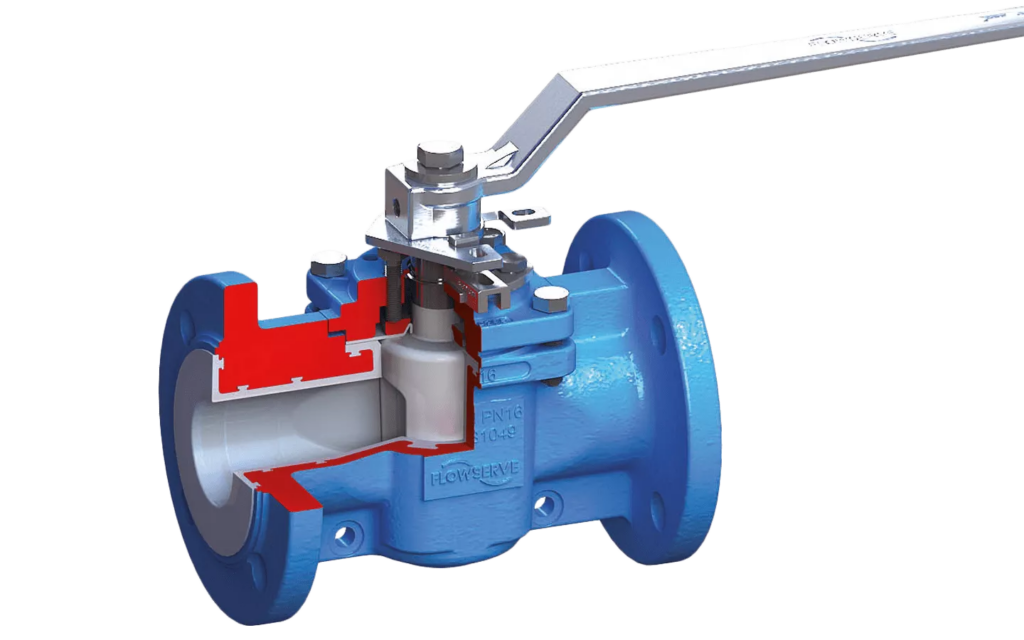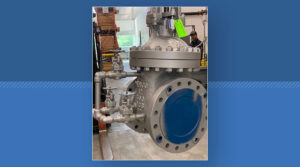Lined Valves

Lined valves play a crucial role in industrial setups where reliability and precision are paramount. The design of these specialized valves enables them to handle aggressive media as they provide a protective layer to ensure integrity and longevity of the valve. In this article, we delve into the purpose of lined valves, explore various types such as glass, PFA, PTFE, rubber, TEF, and FEP, as well as compare them with unlined valves.
Purpose of Lined Valves
The use of lined valves is common in industries that deal with corrosive or abrasive fluids. Primarily, the lining serves as a shield, which protects the valve’s internal components from chemical attacks and erosion. As such it ensures service life extension and the minimization of maintenance requirements. This is why these valves are common in sectors where reliability is key, such as pharmaceuticals, petrochemicals, chemical processing, and wastewater treatment. Other benefits of using lined valves include:
-
- Minimization of leakages, so they are ideal for fugitive emission applications.
-
- Improves temperature resistance of valves when linings such as Teflon are used.
-
- Can serve as a more economical alternative to using high-grade alloys in certain applications.
Types of Lined Valves
There are several types of lining materials, and this section reviews common options for industrial valves and their features.
Glass
-
- This is a common choice for valves that control corrosive acids and alkalis.
- In addition, it offers excellent resistance to chemical attacks and high temperatures.
- Although it is relatively fragile, it provides a smooth, non-stick surface.
- Can serve in applications where the temperature is as low as -20℉ (-29℃), and as high as 500℉ (260℃). But specialized models for cryogenic valves can operate as low as -76℉ (-60℃).
-
- An ideal choice where purity is important, such as in the pharmaceutical and food processing industries.
- This is a common choice for valves that control corrosive acids and alkalis.
PFA
-
- Perfluoroalkoxy (PFA) lining is suitable for a wide range of applications containing corrosive media.
-
- Maintains high purity levels and is resistant to both chemicals and extreme temperatures ranging between -20℃ and 240℃.
-
- Similar to glass-lined valves, PFA lining provides a non-stick surface which minimizes the risk of contamination. Thus, it is common in pharmaceutical and semiconductor industries.
Rubber
-
- The lining on these valves can be from materials like Neoprene and EPDM, which offer flexibility and resilience.
-
- They protect against abrasion and corrosion. Thus, they are ideal for handling abrasive slurries and fluids with suspended solids.
-
- Its operating temperature varies according to the type of rubber lining in use, with the range typically between -40℃ and 120℃. However, fluoro-silicone rubber can withstand up to 160℃.
-
- A popular choice in mining and wastewater treatment applications.
PTFE
-
- Polytetrafluoroethylene (PTFE) lining is one of the most popular because of its exceptional chemical resistance.
-
- It is suitable for applications involving strong acids, bases, and corrosive solvents.
-
- Generally, its operational temperature range lies between -45℃ and 240℃.
-
- Also, this lining provides a low-friction surface that reduces the risk of blockages.
-
- Common in chemical and petrochemical industries.
TFM
-
- This is a second-generation PTFE material that combines all its strengths with better stress recovery and the ability to handle higher temperatures and pressures.
-
- TFM operating temperature ranges between -100℉ and 450℉.
-
- Experiences substantially lesser deformation and creep during loading.
-
- Provides a smoother surface finish on machined parts.
FEP
-
- Also a version of PTFE, so it has all its benefits such as non-stick, versatility, as well as chemical and corrosion resistance.
-
- Has good electrical insulation properties, so it suits applications where conductivity is a concern.
-
- The operating temperature range is -20℃ and 240℃.
-
- It is transparent, thus enabling visual inspection of flow.
Lined vs Unlined Valves
Valve specification depends on the needs of a project as well as budgetary provisions. The following table compares them across various aspects.
| Parameter | Lined Valves | Unlined Valves |
| Corrosion Resistance | Has excellent resistance to chemical attacks | Is susceptible to corrosion. If the media is highly corrosive, then high-grade alloy is used, which is more expensive than lined valves. |
| Temperature Resistance | Can handle a wide range of temperatures, depending on the lining material. | Generally, they are limited in temperature resistance. |
| Longevity | Effective against abrasion and slurries; its smooth surface facilitates cleaning. This contributes to design life extension. | Prone to wear and clogging in abrasive and slurry conditions, respectively. Conclusively, they may experience a shorter lifespan. |
| Maintenance | Low maintenance | Requires frequent maintenance or expensive high-grade alloys in harsh environments. |
| Flexibility | Offers a variety of materials to choose from | Material choice is limited |
| Cost | Generally more expensive due to specialized material | More economical in non-corrosive applications |
| Environmental Impact | Some constitute environmental concern due to the disposal of damaged linings. | Leaves less footprint on the environment. |
This comprehensive comparison highlights the superior performance of lined valves across multiple aspects, making them a popular choice in demanding industrial scenarios. Whether it is the resistance to corrosion, temperature resilience, or suitability for specific applications, lined valves generally demonstrate better efficiency, reliability, and durability. As industries continue to evolve, the demand for lined valves is likely to continue to rise driven by the need for robust solutions in handling challenging fluids and environments.


